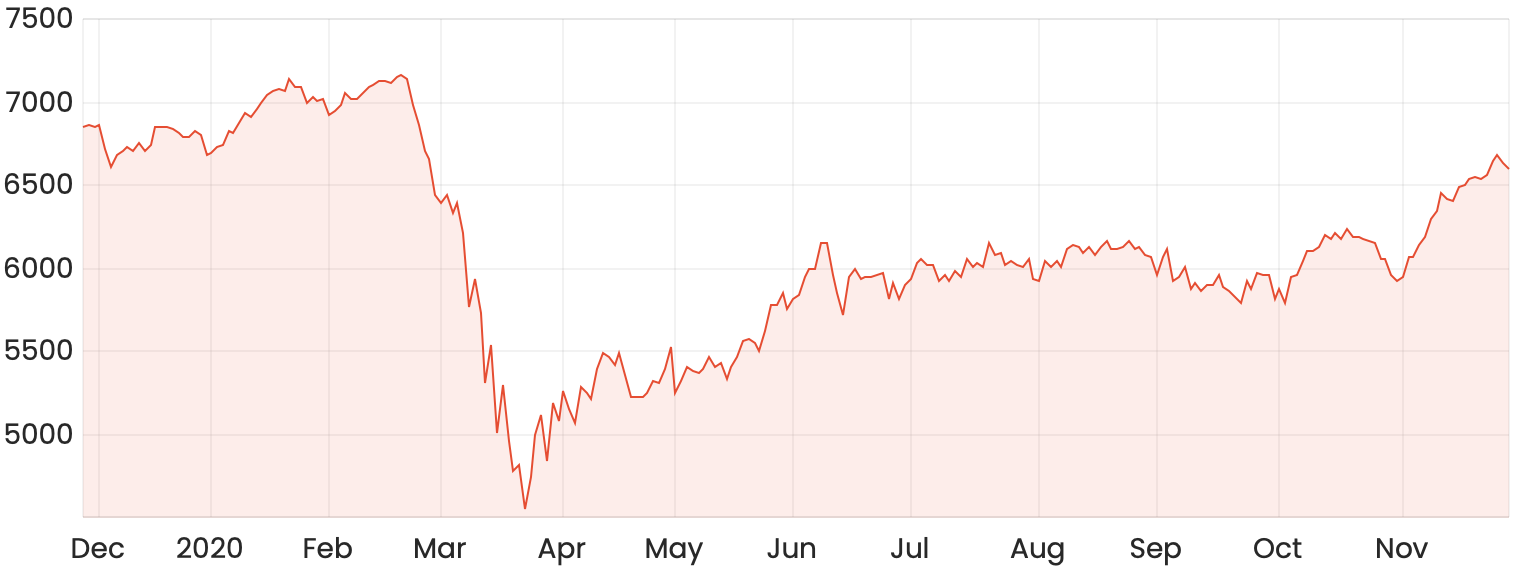Many of the big four ASX banks continued their impressive winning streaks last week with investors continuing to rotate out of the previous COVID-19 beneficiaries.
The banks have helped to drag up the broader S&P/ASX 200 (ASX: XJO) in recent weeks, which is now only just 8% lower than its pre-COVID level.
ASX 200 chart

Why are ASX bank shares rallying?
Like many of the hotter sectors at the moment, it’s the result of the string of vaccine announcements which could potentially see a faster economic recovery than what was previously expected.
Banks are cyclical businesses and are sensitive to the underlying economic conditions in which they operate and rely on issuing income-generating assets such as mortgages to borrowers.
With rising consumer confidence in the Australian economy, this could mean more people would now be willing to borrow more money to buy a new house or expand their business, as an example.
Why do investors buy bank shares?
The big four banks have been the quintessential ASX blue-chip shares that have traditionally been overweighted in many investors’ portfolios.
In my eyes, two of the main reasons behind this would be a strong history of dividends, as well as bank shares typically being safe and reliable compared to more volatile sectors.
1. Dividends
Dividends remain to be one of the key determinants that are dragging down the overall performance of the banking sector.
It is still largely unknown at this point how bad debts and loan deferrals will impact the banks’ ability to maintain dividends in at least the short-term.
Some better news is that APRA has recently hinted towards the potential expiry of the ceiling of payout ratios which previously prevented banks from paying out more than 50% of profits in the form of a dividend.
However, I don’t necessarily think that the big four banks are completely out of the woods yet, as some have pointed out that as government stimulus gradually tapers off next year, banks could continue to struggle with additional pressure on their loan books.
2. Security
Especially after the 2007 Global Financial Crisis, the banking industry has been increasingly regulated with strict rules surrounding how much, and what sort of, capital a bank must hold relative to its risk-weighted assets.
Additionally, we’ve seen in other countries how governments and central banks have bailed out their commercial banks in times of financial distress, unfortunately often at the expense of the taxpayer. Banks engaging in risk-taking behaviour knowing there’s always a safety mechanism is referred to as moral hazard.
Australia’s banks didn’t go through the same level of financial distress in 2007, however, I do think the “too big to fail” belief still weighs in on investors’ sentiment towards ASX banks shares today.
Additional headwinds for ASX banks
It’s important to remember that the RBA has indicated we can expect to have a cash rate close to 0% for at least the next three years.
Banks face a headwind in a low interest-rate environment because they already pay very little amounts of interest on their customers’ deposits. Therefore, a further decrease in interest rates does little to reduce the amount of interest they pay on these deposits. However, because banks will collect less interest on their interest-bearing assets such as loans, this will inevitably compress their margins and make them less profitable.
Additionally, there’s an evolving competitive landscape with buy now, pay later (BNPL) providers and other fintechs trying to capture some of the market share that banks have traditionally had a monopoly of in the past.
While I’m not too convinced on some of the neo-banks, I do think the growth of a company like Tyro Payments Ltd (ASX: TYR) is a good example of how we’ve seen a shift in the preference towards small companies that offer more competitive merchant banking services.
Now what?
If many ASX investors choose to buy bank shares for a combination of dividends and security, half the thesis is already busted given the current outlook for dividends.
I think a truer reflection of the underlying health of these banks will be exposed next year when the stimulus has finally dried up. Up until then, for me, it would be speculative to assume that there wouldn’t be any flow-on effects from COVID-19 and dividends will be able to be paid as normal.
This, in combination with the various other previously mentioned headwinds, confirms my less than ideal level of conviction towards ASX bank shares at the moment.
I’d much rather invest in companies where there are secular trends working in their favour, rather than against them. For a few shares that I believe fit this category, here are three ASX shares with secular tailwinds that I’m liking at the moment.
And if you’re on the hunt for dividends, here are three of my favourite ASX dividend shares right now.











